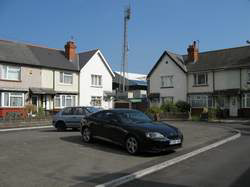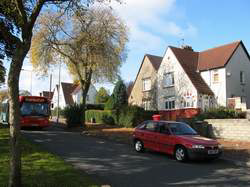Abandoned Communities ..... Temperance Town
What is very clear is that the Corporation made no attempt at all to consult the people of Temperance Town about the demolition of their district. Moreover, on occasions when groups or individuals wrote to the Corporation with suggestions, complaints, or requests, the response was often negative. On 7 April 1933, for example, a letter came from the Cardiff Ratepayers’ Association. It recommended that the proposed bus centre should not be decided upon until the facts and figures had been placed before the public, and the ratepayers had had a chance to go into this important matter. A deputation from the CRA was received by the General Purposes Committee on 4 May, and at least two councillors supported a deferment of the scheme for one month. The committee, however, decided that the scheme should go ahead without delay.
Much later in the process a letter dated 15 June 1936 came from the Cardiff and District Unemployed Workers’ Association asking that Wood Street Area Improvement Sub-Committee should receive a deputation with reference to the rehousing of tenants and sub-tenants. The sub-committee resolved that no useful purpose would be met by receiving such a deputation.
To be fair, the sub-committee tended to be a little more flexible in reply to requests from the people of Temperance Town related to impending transfers to new housing. At a meeting on 17 February 1936 they considered a petition from the residents of 1-24 Eisteddfod Street, who wanted to be moved together to Sloper Road. They authorised the officials concerned to meet the request of the petitioners as far as possible. At their next meeting they had to endorse a reply by the Town Clerk to a letter from the residents of Scott Street asking that they should be rehoused first. The Town Clerk had stressed that no question of preferential treatment arose, but the sub-committee resolved that as it was desirable to demolish first the houses in Scott Street, the tenants and protected sub-tenants of those houses should be rehoused as soon as possible.
As you read the proceedings of the various committees you are struck by the absence of any evidence of concern for the welfare of the people affected by the project. There is no indication of awareness of the likely emotional reactions to being evicted from your home and the dispersal of your community. From time to time the proceedings refer to the residents of Temperance Town as “persons of the working class”. This blanket term may have allowed Cardiff Corporation to avoid attending too closely to the needs and feelings of individual residents, and you wonder also whether it had connotations that made it easier for councillors and corporation staff to avoid any responsibility to consult the people of Temperance Town.
Having said that, when the time came to start planning the resettlement of the 1300 or so people living in Temperance Town the Corporation took the task of rehousing very seriously. At first it was hoped that the majority of people could be moved together to a new estate at Sloper Road, about a mile to the west, and very close to the Cardiff City football ground. In the event some people from Temperance Town did indeed move to the Sloper Road estate, but they shared the area with others who also required council accommodation. Others were transferred to new estates in Tremorfa, two miles to the east, and in Ely, roughly three miles to the west.
To their credit Cardiff Corporation seems to have resisted government guidance encouraging local authorities to rely more on private housing developers. Spacious streets were laid out in all three areas mentioned above, and the quality of housing was high. The majority of dwellings had two bedrooms, while some had three or four.
Rehousing was offered to all those tenants and sub-tenants who had lived at their address since the date of the Cardiff Corporation Act, 31 July 1934. A problem arose with others who moved in as sub-tenants after that date, and it appears that some of these people had to be evicted just before the process of demolition began.
Much later in the process a letter dated 15 June 1936 came from the Cardiff and District Unemployed Workers’ Association asking that Wood Street Area Improvement Sub-
To be fair, the sub-
As you read the proceedings of the various committees you are struck by the absence of any evidence of concern for the welfare of the people affected by the project. There is no indication of awareness of the likely emotional reactions to being evicted from your home and the dispersal of your community. From time to time the proceedings refer to the residents of Temperance Town as “persons of the working class”. This blanket term may have allowed Cardiff Corporation to avoid attending too closely to the needs and feelings of individual residents, and you wonder also whether it had connotations that made it easier for councillors and corporation staff to avoid any responsibility to consult the people of Temperance Town.
Having said that, when the time came to start planning the resettlement of the 1300 or so people living in Temperance Town the Corporation took the task of rehousing very seriously. At first it was hoped that the majority of people could be moved together to a new estate at Sloper Road, about a mile to the west, and very close to the Cardiff City football ground. In the event some people from Temperance Town did indeed move to the Sloper Road estate, but they shared the area with others who also required council accommodation. Others were transferred to new estates in Tremorfa, two miles to the east, and in Ely, roughly three miles to the west.
To their credit Cardiff Corporation seems to have resisted government guidance encouraging local authorities to rely more on private housing developers. Spacious streets were laid out in all three areas mentioned above, and the quality of housing was high. The majority of dwellings had two bedrooms, while some had three or four.
Rehousing was offered to all those tenants and sub-
Four
A cul-de-sac on the Sloper Road estate
Houses in Grand Avenue, Ely

